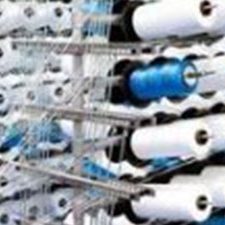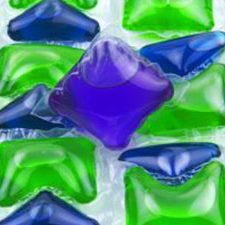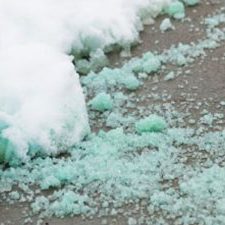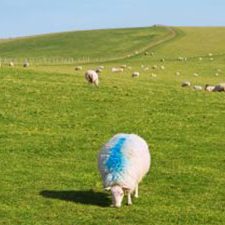Coloration of a product so that it has minimal staining properties when in contact with other items is a unique and challenging goal that requires a unique colorant — Organic Dyes and Pigments’ OrcoTint™NS dyes are polymeric highly concentrated liquid colorants designed to minimize staining on many different industry end-products such as detergents & soap, chemical compounding products, ice-melts, and livestock colorants. OrcoTint™NS colorants provide no staining on skin, textiles, plastics, and processing machinery. This line of colorants is compatible with many systems due to its non-ionic chemical nature and high water-solubility. Their high solubility allows them to be formulated in high dosages in both liquid and solid applications. Beyond the standard OrcoTint™NS line, custom-formulated colors can be developed according to your specific shade and physical property requirements. Current OrcoTint™ NS colorants available consist of the OrcoTint™NS Royal Blue, Blue, Dark Royal 8711, Violet & Bright Green GL, Red & Yellow. New colorants are currently being developed to offer a complete palette of colors.
OrcoTint™NS Product Line Bulletin

Fugitive Tints
Fugitive Tints are a group of dyes that have the unique ability to “disappear” – either through the degradation due to sunlight, or from a rinse with warm water. ORCOTM NS Polymeric Dyes are commonly used in the Textile Industry to temporarily identify fibers where a component differentiation is critical, but permanence is not needed. ORCOTM NS Polymeric Dyes are commonly used in carpet manufacture, fiber production and processing, and in nonwoven production, and as well as in non-textile application in industrial coating for temporary application determination.
Detergents & Soap
Detergents & Soap formulations typically include OrcoTint™NS colorants to minimize staining on skin, textiles, plastics, concrete, ceramics, and processing machinery. Products formulated using OrcoTint™NS colorants include hand sanitation products, foaming soaps, laundry detergent & softeners, and industrial & household cleaning products. OrcoTint™NS colorants are used extensively in liquid, powder, and gel-pack formulations.
Ice-Melt & De-Icing Coloration
Ice-Melt & De-Icing Coloration aids in the visual identification of icy areas that have been treated. With safety being a primary concern in areas such as stairways, pedestrian sidewalks, parking lots, and industrial loading areas, OrcoTint™ NS colorant-treated ice-melts help to minimize dangerous hazards. OrcoTint™NS colorants are the preferred ingredient in ice-melt formulations as they have minimal-to-no staining characteristics when in contact with concrete, asphalt, brick, wood, clothing, shoes, leather, & carpet, and are highly concentrated, environmentally friendly to vegetation, easy-to-use, and visually appealing. They are also non-reactive to salts and are stable in rock salt, calcium chloride, sodium chloride, potassium chloride, calcium magnesium acetate, and magnesium chloride formulations. Further information on OrcoTint NS Dyes for Ice Melt HERE.
Livestock Identification
Livestock Identification is a common practice to temporarily mark and identify livestock for many reasons. Some include herd management and treatment codes for medical, insemination, feeding, milking, and monitoring. OrcoTint™NS colorants easily wash off and are safe for use on aimals and the environment.
Spray Pattern Indicator Agents
Spray Pattern Indicator Agents are formulated in many instances using OrcoTint™NS colorants due to their minimal-to-no staining characteristics and ability to wash off easily. A highly visible “temporary marking” system is desired in many applications such as fertilizer/pesticide/herbicide spraying, turfgrass markings, and industrial & aquatic vegetation management.
Custom Chemical Compounding
Custom Chemical Compounding requires a wide variety of colorants with different physical properties and characteristics. Typically, a chemical is colored mainly for identification, marketing, and branding purposes. This is where OrcoTint™NS colorants fit the bill — they are non-ionic making them chemically compatible in many formulations, are minimally staining or virtually non-staining to many materials, have a wide temperature stability range, and are highly concentrated. Some chemical formulations where OrcoTint™NS colorants are typically used are industrial cleaners, antifreeze, heat-transfer fluids, and rust inhibitors for the water treatment, mining, HVAC, coatings, geothermal, and oil & gas industries.
Click on shade for further information
| Shade | OrcoTint NS™ | Technical Info |
|---|---|---|
 |
Dark Royal 8711 Deep blue suitable in a pH range 4 to 10. |
Technical Bulletin |
 |
Royal Blue Concentrated Royal Blue color for use in pH range of 4-10 |
Technical Bulletin |
 |
Blue Greenish shade blue suitable in a pH range 4 to 10, with slightly greener cast at pH of 4 |
Technical Bulletin |
 |
Violet Strong bluish violet suitable in a pH range of 4 to 10 |
Technical Bulletin |
 |
Bright Green GL Bluish green dye suitable in a pH range of 4 to 10 |
Technical Bulletin |
 |
Red Deep Bluish Red suitable in a pH range of 4 to 10 |
Technical Bulletin |
 |
Yellow Yellow to Yellow-Gold dye suitable in a pH range of 4 to 10 |
Technical Bulletin |
Actual OrcoTint NS™ samples must be evaluated in a laboratory on medium to be colored in production for accurate shade, physical properties, and degree of non-staining results. Shades shown on print material and computer monitors are for general reference only as they are inherently inaccurate due to calibration variations and technical limitations of monitors and printers.





